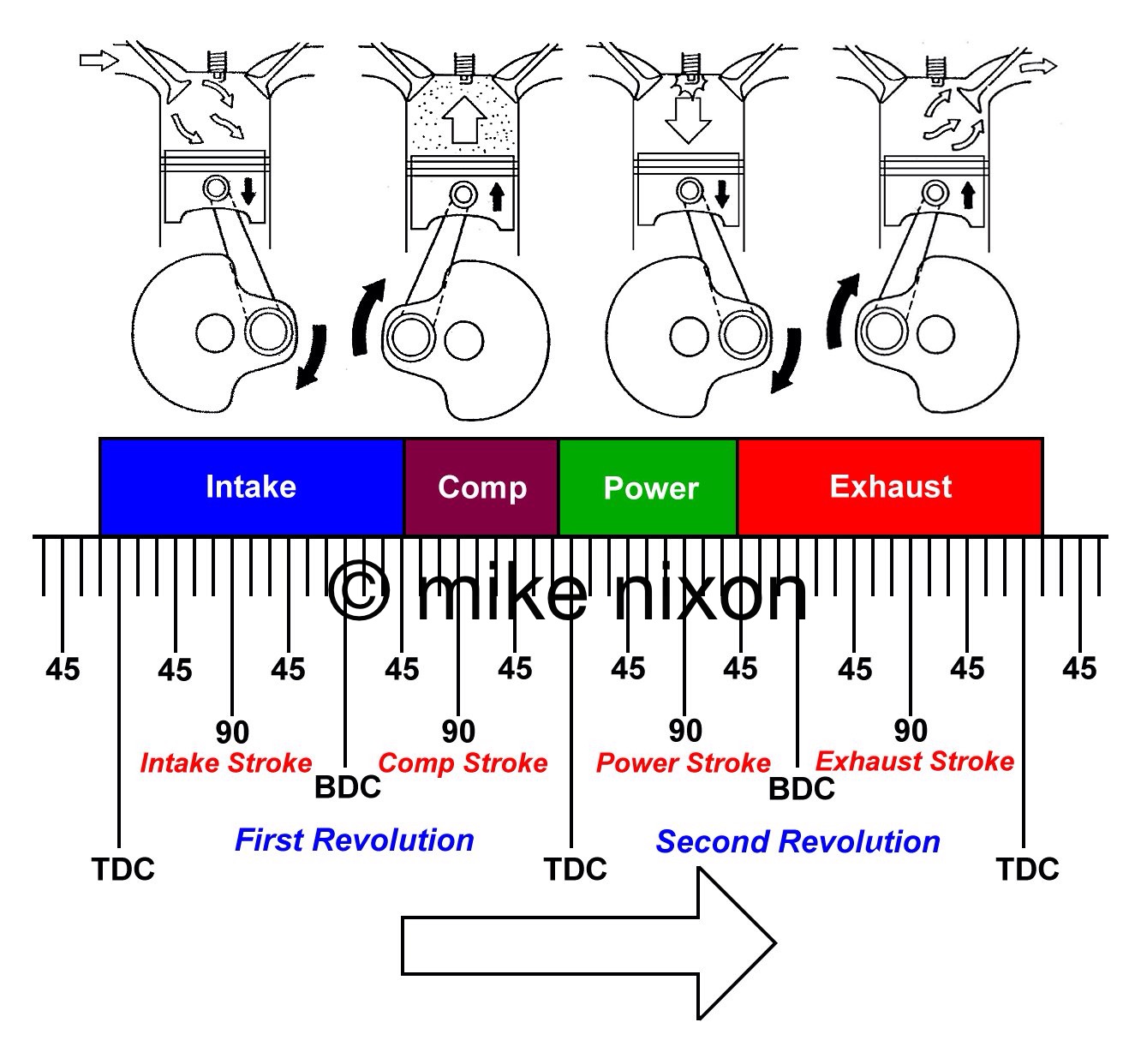
|
|
Intake, compression, power, exhaust. The traditional, well-known four-stroke events. Note how the intake event starts before top dead center and the exhaust event continues a bit past top dead center on the next stroke. Also, combine the beginning of the graph and its end to visualize valve overlap.
|
Remember how a four-stroke engine works? Negative pressure from the downward moving piston draws in the air/fuel mixture and after the piston and reached bottom dead center and is on its way up again the intake valve closes and the mixture is compressed. Just before the piston reaches top dead center the spark plug fires, igniting the mixture that due to compression is so agitated it is almost ready to ignite on its own. The burning mixture creates a huge amount of pressure in the cylinder, pushing the piston forcefully down, and after reaching bottom dead center the second time the piston returns upward to push the spent gases out of the cylinder and into the exhaust system. Just before reaching top dead center the exhaust valve closes while the intake valve opens and the cycle begins anew.
Combustion
There are a lot of mysterious things going on here. For example, wave influences and sonic pulses - within both the intake and exhaust plumbing - partner with the piston's movement to augment flow and assist the valves in their roles. Valve overlap, that brief moment when the intake and exhaust valves are both open, adds a cleansing effect to the exhaust as well as a pull on the intake. And there is more. As the engine speeds up, combustion does not and at a certain point it gets rushed too much so compensation is needed in the form of earlier ("advanced") ignition. And even then, every engine has a point at which its rpm is so high that combustion suffers and only the increasing rpm is responsible for more power, and even that drops off eventually when torque's (the child of combustion) fall gets ever steeper.
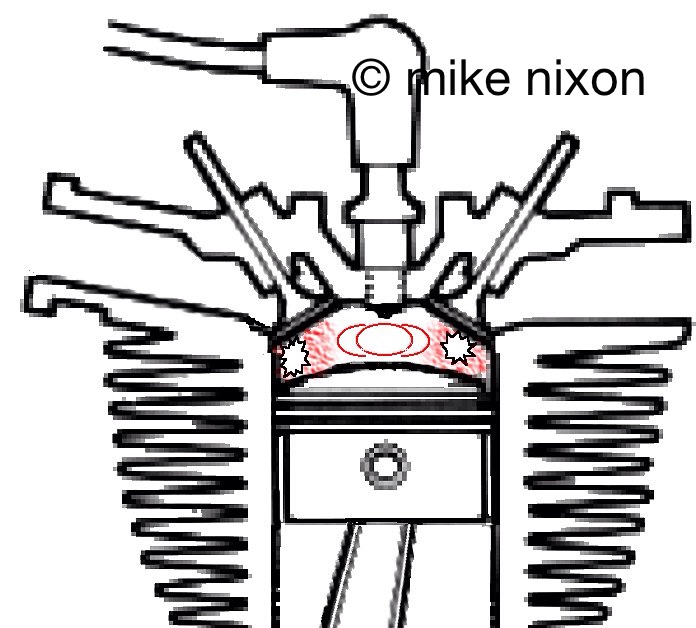
|
|
Detonation is simply the spontaneous self ignition of air/fuel mixture at the edges of the combustion chamber that have not yet been reached by the rolling flame front. The more convulted the combustion chamber, the more end gases are trapped.
|
Detonation
You'll begin to understand much if you will first digest this: combustion is not an explosion. Rather, it's a uniform, steady, controlled burn. It seems like powie to us, but to the engine, it is as gradual as the surf rolling onto shore.
The heat of ignition's spark ignites the air/fuel molecules within the spark plug gap. This miniature ball of flame grows outward in a steady, ever-widening circle, like the concentric ripples created when a rock is dropped into a pond, until it reaches the edges of the combustion chamber. All the while combustion has been ongoing, only finishing after the piston has reached bottom dead center and is partway up the cylinder again. A steady, even push. Nothing jerky, nothing explosive.
Combustion is so slow in fact that it has to have a head start. It has to begin before top dead center in order for its pressure peak to occur at that point. And as the engine speeds up, combustion is initiated even earlier to compensate for an engine that is going faster but a combustion which cannot.
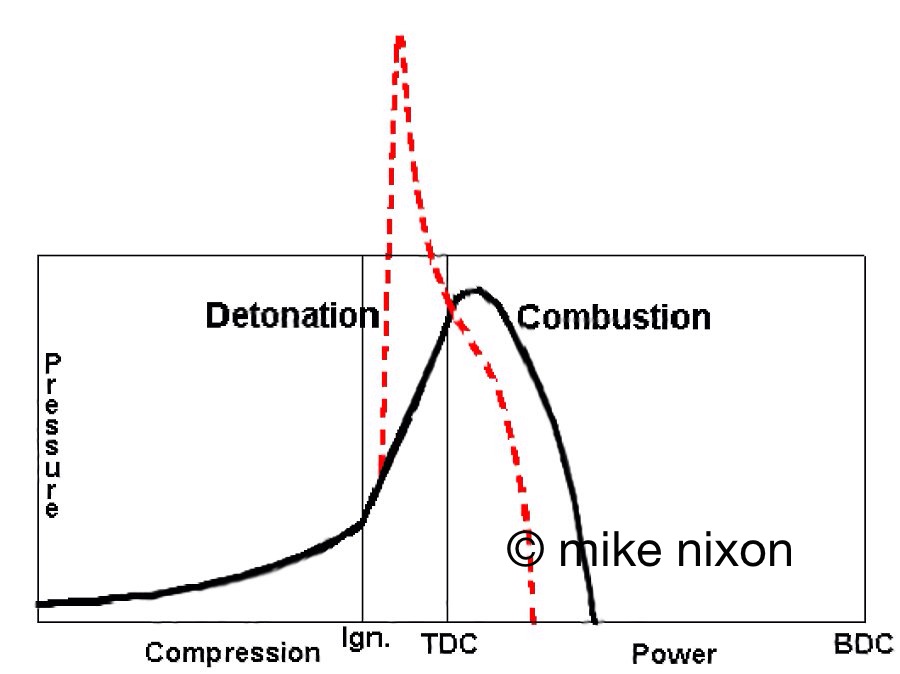
|
|
Imagine the energy produced by the engine (and contained in the fuel as heat energy, or BTU) as a long string. Nothing can change the energy, it's there no matter what happens. Detonation merely reshapes the string. Instead of spread evenly over many crankshaft degrees, the heat energy spikes almost instantaeneously, the concentration of power breaking parts instead of gently pushing them.
|
Because combustion starts before TDC, for a short period the piston is compressing an already-burning mixture. Think about that for a moment. Not only is combustion's flame heating uo the cylinder, but so is the still-rising piston. This is hard on the fuel, which, twice-heated, is easily overheatd. The air/fuel mixture that the advancing flame has not yet reached, mixture at the cylinder's edges, commonly called end gas, is agitated by this extra heat. When this end gas gets overheated before combustion's flame can reach it, and ignites on its own, this is called detonation. The mixture explodes, or detonates. Detonation is indeed an explosion, abnormal combustion. As a result, the piston receives an intense, localized shock wave, instead of the steady forceful push it was designed for. The result of this detonation is often cracked pistons, and always loss of power. You can appreciate why there is as power loss when you see the following graph depicting normal combustion's force overlayed with that of detonation.
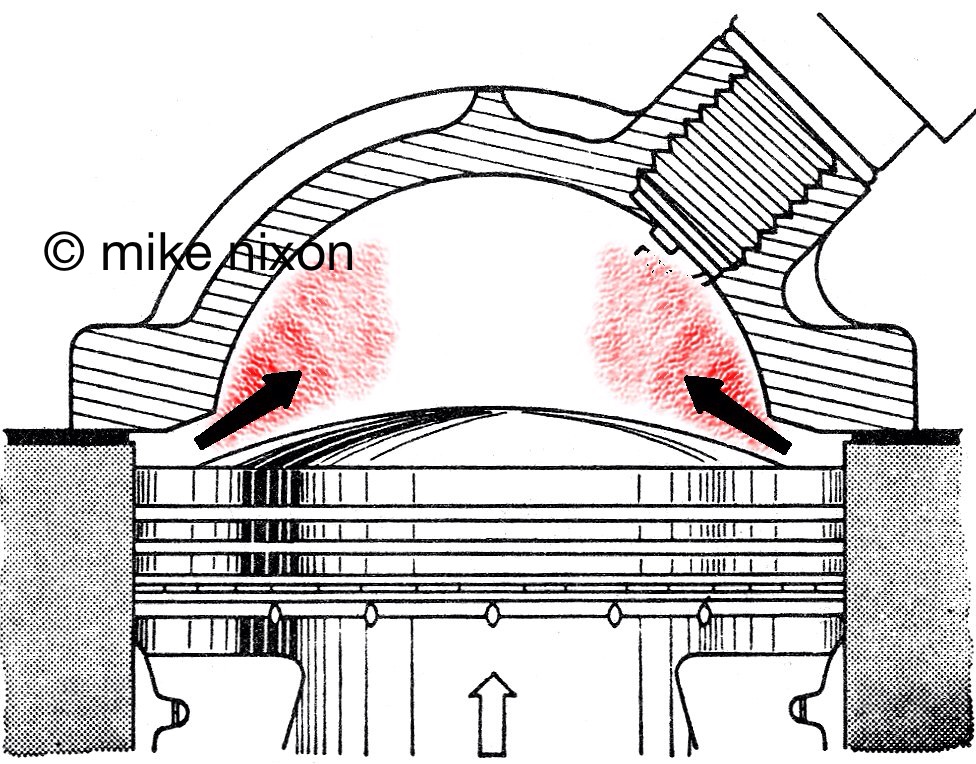
|
|
The idea behind squish is to push out end gases, getting them into combustion's flame before they can be squeezed so much they light off on their own. Before squish began to be developed there was a heavy reliance on octane. Octane simply interposed a chemical barrier (tetra-ethel lead) between fuel molecules, preventing them from conducting heat one to the other, thus making the fuel more compressible and less likely to spontaneously ignite.
|
Squish
Today's combustion chambers are carefully shaped to discourage end gases from forming. Mostly they are much flatter than in times past, so that high topped pistons are not needed to get adequate cylinder compression. Of course these flat chambers are possible only with very nearly vertically positioned valves, and they in turn are possible only because of liquid cooling. A less important part of this shaping is called squish. Squish is simply the tiny space between the piston's edge and the cylinder head. The squish area squirts end gases into the center of the chamber where they are consumed and not pre-heated to the point of self-ignition.
Preignition
Folks often confuse detonation and preignition. Preignition is another, but very different combustion abnormality. Unlike detonation it is not an explosion, but rather combustion that is begun at the wrong time. Preignition also has nothing to do with end gases. An engine pre-ignites when a hot spot develops in the cylinder that is able to ignite the air/fuel mixture before it's supposed to be ignited. This hot spot may be a piece of carbon in the cylinder, such as shown below. It may be the edge of a gasket that has jutted out into the cylinder. Preignition overheats the engine, eventually leading to a melted piston crown, and can initiate and be accompanied by detonation. Here are the distinctives between detonation and preignition.
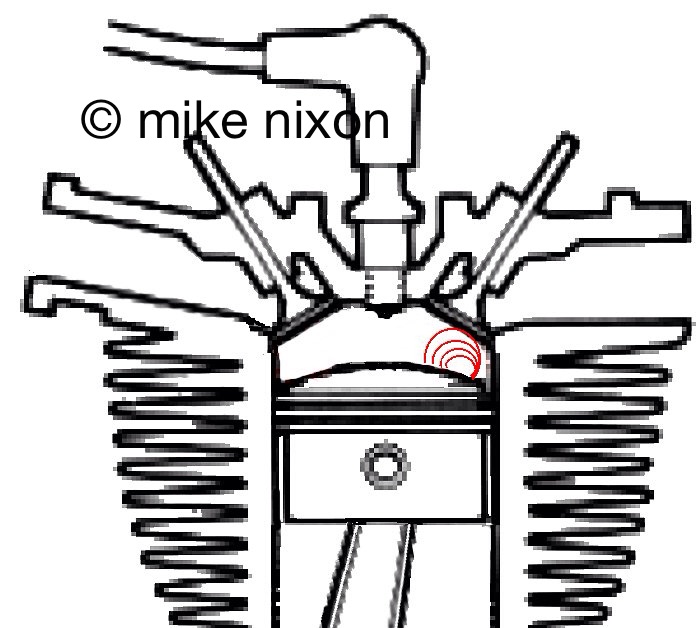
|
|
Preignition is normal combustion, just early. A hot spot develops and the air/fuel mixture is ignited just as if the spark plug did it. No shock waves, no misuse of the heat energy, just uncontrolled ignition timing. Preignition and detonation are different, but preignition can add to combustion's heat, and thus can lead to detonation.
|
|
Detonation
|
- Detonation is the spontaneous explosion of the cylinder's end-gases.
- Detonation occurs after normal combustion has already begun, that is, after ignition.
- Detonation is evidenced by cracks in the piston, and sometimes by failed bearings.
|
|
Preignition
|
- Preignition is untimed combustion resulting from a hot spot that becomes an alternate source of ignition.
- Preignition occurs before normal combustion.
- Preignition is evidenced by a partial melting of the piston.
|
|

 ®
®




